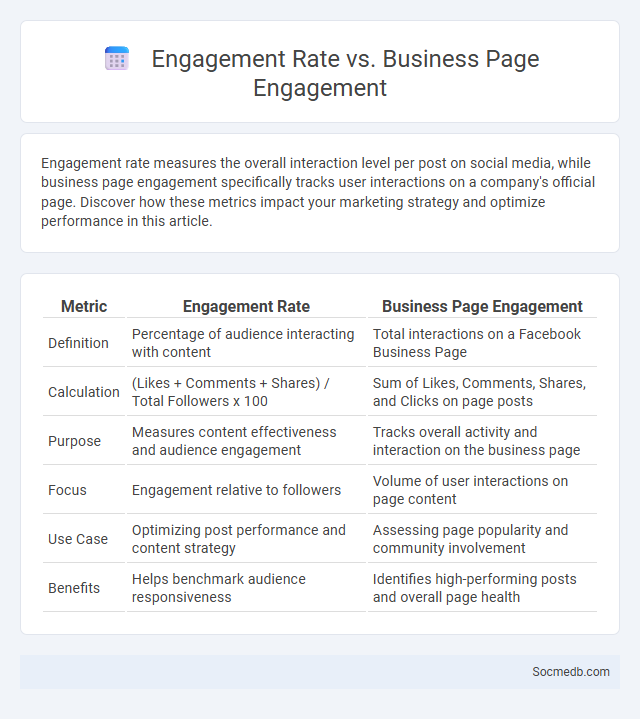
Photo illustration: Engagement Rate vs Business Page Engagement
Engagement rate measures the overall interaction level per post on social media, while business page engagement specifically tracks user interactions on a company's official page. Discover how these metrics impact your marketing strategy and optimize performance in this article.
Table of Comparison
| Metric | Engagement Rate | Business Page Engagement |
|---|---|---|
| Definition | Percentage of audience interacting with content | Total interactions on a Facebook Business Page |
| Calculation | (Likes + Comments + Shares) / Total Followers x 100 | Sum of Likes, Comments, Shares, and Clicks on page posts |
| Purpose | Measures content effectiveness and audience engagement | Tracks overall activity and interaction on the business page |
| Focus | Engagement relative to followers | Volume of user interactions on page content |
| Use Case | Optimizing post performance and content strategy | Assessing page popularity and community involvement |
| Benefits | Helps benchmark audience responsiveness | Identifies high-performing posts and overall page health |
Understanding Engagement Rate: Definition and Importance
Engagement rate measures the level of interaction your audience has with your social media content, typically calculated by dividing total engagements (likes, comments, shares) by your follower count or impressions. This metric provides critical insights into how effectively your content resonates with your target audience, helping you refine strategies to boost visibility and brand loyalty. Improving your engagement rate can directly impact your social media growth and conversion rates.
What is Business Page Engagement? Key Metrics Explained
Business page engagement on social media measures how users interact with brand content, reflecting audience interest and loyalty. Key metrics include likes, comments, shares, click-through rates, and follower growth, which help assess content effectiveness and customer connection. Tracking these indicators enables businesses to optimize strategies, boost reach, and drive conversions.
Engagement Rate vs Business Page Engagement: What’s the Difference?
Engagement rate measures the percentage of interactions such as likes, comments, and shares relative to the total followers or impressions, providing a standardized metric to evaluate content performance. Business page engagement refers to the actual volume of user interactions occurring specifically on a brand's social media page, reflecting direct audience involvement with the page's posts. Understanding the distinction helps marketers optimize strategies by balancing quantitative reach with qualitative interaction to drive meaningful brand connections.
Calculating Engagement Rate: Methods and Best Practices
Calculating engagement rate involves measuring interactions such as likes, comments, shares, and clicks relative to your total followers or reach, providing a clear indicator of content effectiveness on social media platforms. Common methods include the engagement-to-follower ratio and engagement-to-reach ratio, both essential for assessing audience responsiveness. Applying best practices such as tracking metrics consistently, segmenting data by post type, and benchmarking against industry standards helps you optimize content strategies for maximum impact.
Business Page Engagement Metrics: How to Track Performance
Tracking Business Page Engagement Metrics on social media is essential for measuring content effectiveness and audience interaction. Key performance indicators include likes, shares, comments, click-through rates, and follower growth, which collectively indicate user engagement and brand reach. Utilizing analytics tools like Facebook Insights, Instagram Analytics, or LinkedIn Page Analytics enables businesses to monitor these metrics in real time and adjust strategies to maximize performance and ROI.
Factors that Influence Engagement Rate
Content relevance and quality significantly influence social media engagement rates by capturing Your audience's interest and encouraging interaction. Timing and frequency of posts also play a critical role, with optimal posting schedules maximizing visibility and user activity. Furthermore, the use of compelling visuals, hashtags, and interactive elements like polls or questions boosts engagement by fostering connection and participation.
How Business Page Engagement Reflects Audience Loyalty
Engagement on your social media business page, such as likes, comments, and shares, directly reflects the loyalty and trust your audience has in your brand. High interaction rates indicate that your content resonates with followers, encouraging repeat visits and fostering a community around your products or services. Tracking these engagement metrics provides valuable insights into customer satisfaction and helps tailor strategies to maintain long-term relationships.
Engagement Rate Benchmarks by Industry
Engagement rate benchmarks vary significantly across industries on social media, with the average rates for sectors like fashion and beauty reaching around 1.5% to 3%, while B2B industries typically experience lower engagement between 0.5% and 1%. Consumer brands, especially in retail and entertainment, often see higher interaction due to visually-driven content that resonates with audiences. Monitoring platform-specific metrics, such as likes, comments, shares, and click-through rates, is essential for brands to tailor strategies and improve overall engagement performance.
Strategies to Improve Both Engagement Rate and Business Page Engagement
Boosting your social media engagement rate requires consistent posting of high-quality, relevant content tailored to your target audience's interests and needs. Use interactive elements such as polls, questions, and live videos to foster genuine conversations and increase user participation on your business page. Analyzing platform-specific data and adjusting your posting schedule based on peak activity times can significantly enhance your visibility and interaction levels.
Choosing the Right Metric for Your Social Media Success
Selecting the right social media metric is essential for accurately measuring your campaign's impact and guiding strategic decisions. Key performance indicators such as engagement rate, reach, conversion rate, and follower growth provide valuable insights tailored to your specific goals. Understanding which metric aligns with your objectives enables you to optimize content, allocate resources efficiently, and maximize overall social media success.
 socmedb.com
socmedb.com